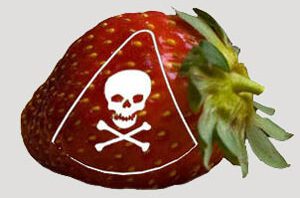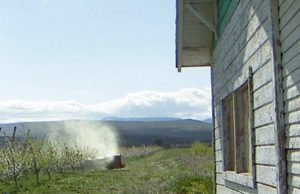Paul Towers, Pesticide Action Network
ptowers@panna.org, Cell: 916-216-1082
March 20, 2012
High Levels of Hazardous Pesticide Found in Air
Drift Catching highlights risk of methyl iodide-like pesticides to rural communities near California strawberry fields, need for State action
SACRAMENTO, CA—Families with children living near Red Bluff, California, brought their concerns about exposure to cancer-causing pesticides to the state’s capital today. They’d detected high concentrations of a fumigant applied to strawberry fields in air near their homes. The results come as California’s new Department of Pesticide Regulation chief, Brian Leahy, weighs the options for handling methyl iodide, a controversial cancer-causing soil fumigant pesticide approved in the final days of the Schwarzenegger Administration.
The group of residents from the Bend District, a rural Tehama County community,decided to find out for themselves what’s in the air around their homes. They organized “Healthy Tehama Farms” in 2010 to take action to protect their neighborhood from fumigant exposure.
Soil fumigants are applied at very high rates per acre and readily transform into a gas, becoming difficult to control and prone to drift away from the application site. Like many rural communities, especially in the Central Valley and Central Coast, people in Bend live very close to strawberry fields that are fumigated annually.
In December 2010, when the Schwarzenegger Administration approved methyl iodide, Bend District residents became increasingly concerned about their health. And because many children live in the community, including seventeen around the most recently fumigated field, they decided to measure the pesticides in air from farming operations conducted by Driscoll’s, the nation’s largest strawberry distributor, to see if they were being exposed to hazardous levels of pesticides.
“We decided to take action when state officials failed to provide protection for rural communities and our children,” said Manuel Silveira, coordinator of Healthy Tehama Farms. “Equipped with scientific tools, including the Drift Catcher, we’ve shown that drift from application of fumigant pesticides is a real and present danger.”
Pesticide Action Network invented the Drift Catcher to address a void in the science around pesticide exposure: previously rural communities could describe being subject to pesticide drift and the illnesses that followed, but they had little proof. The Drift Catcher is a simple, inexpensive and scientifically robust device that collects air samples which can then be analyzed for pesticides. It enables farmworkers and community members to document and draw attention to otherwise invisible chemical exposures.
Because only a handful of farms have used methyl iodide in the year-plus since it was approved for California, Silveira and his neighbors sampled the air in their yards for chloropicrin, a pesticide commonly combined with other fumigants, including all current formulations of methyl iodide (trade name: Midas™). Chloropicrin is a severe respiratory irritant, causing permanent damage to the lungs, and is a potent carcinogen.
The community found the fumigant in every sample they took, with eight-day averagechloropicrin levels at the sites four to five times higher than the level determined to be protective against respiratory damage for a short-term exposure for children (2.4 μg/m3) by the scientists at the California Department of Pesticide Regulation (DPR), the agency’s own Scientific Review Panel and scientists at the California Office of Environmental Health Hazard Assessment. The maximum measured 24-hour concentrations exceeded the acceptable levels for 24-hour exposures by 18 to 29 times for children and nine to 14 times for adults.
In addition, cancer risks from exposures to chloropicrin in the Bend were high, with a lifetime cancer risk 151 times higher than the generally acceptable risk. For a two-year old exposed each year for only two years, the cancer risk is 76 times higher. Chloropicrin has been shown to cause lung cancer in mice.
“This study illustrates how readily fumigants can move away from where they are applied at levels that can have serious health impacts on neighbors,” said Dr. Susan Kegley, consulting chemist for Pesticide Action Network. “Methyl iodide evaporates even more readily from soil than chloropicrin does, and used in conjunction, these two fumigants will pack a carcinogenic punch that no one should have to tolerate. Director Leahy must show his commitment to public health and scientific integrity by revoking the ill-advised decisions of the Schwarzenegger administration that allow exposures to levels of these fumigants that far exceed those deemed acceptable by Department of Pesticide Regulation toxicologists.”
Methyl iodide was approved in 2010 despite concerns voiced by both a panel of independent scientists and the DPR’s staff scientists. The panel’s chair has called it “one of the most toxic chemicals on earth,” citing research that methyl iodide causes cancer, late-term miscarriages and contaminates groundwater. And over 200,000 scientists, farmers, farmworkers, environmentalists and other members of the public sent comments to the U.S. Environmental Protection Agency last May urging the federal agency to follow the science and ban the pesticide nationally. Washington State used California’s research to reject methyl iodide, and federal regulators have suggested that they are waiting on California in order to determine their next steps.
Earlier this month, DPR Director Leahy signaled a new direction for strawberry growing in California by partnering with the California Strawberry Commission to invest in alternatives to pesticide fumigants. Over 85% of the nation’s strawberries are grown in the state, and growers have long relied on fumigants like methyl bromide and chloropicrin, facing few other options or support from state officials.
“It’s time to spur innovation in California agriculture, as well as ensure greater long-term stability for growers,” said Dr. Kegley. “Sticking to the science and promoting safe alternatives will reduce pesticide use, protect children’s health, and support climate-friendly agriculture.”
Despite high fumigant use in conventional agriculture, California leads the country in organic farming with over 430,000 acres in production and average annual growth of 15%. And farmers and entrepreneurs are looking for alternatives to pesticide fumigants. Current and emerging alternatives include solarization, steam treatments, crop rotations, use of green manures such as mustard seed meal, and anaerobic disinfestation.
Residents in the Bend District can’t afford to wait around for long. The issue takes on renewed urgency as local officials are currently weighing another decision to allow Driscoll’s to fumigate fields in the Bend in March.
“We’re on the front lines of pesticide exposure,” said Sam Sleezer, a member of Healthy Tehama Farms who placed a Drift Catcher in his childrens’ sandbox. “These levels of pesticide exposure for our children are unacceptably high, and deserve swift and immediate action from local and state officials to ensure protection.”
Mary-Ann Warmerdam, DPR Director under Governor Schwarzenegger, set the regulatory target level of exposure to chloropicrin 79 times higher than the scientists recommended for children at 490 μg/m3. This action is similar to Warmerdam’s decision regarding methyl iodide, which allows for exposure over 100 times higher than the levels recommended by the Department’s toxicologists and a scientific peer-review panel. Although the Department of Pesticide Regulation listed chloropicrin as a Toxic Air Contaminant in January 2011, no restrictions on its use have yet been implemented.
Several Central Valley counties now require large buffer zones for fumigations, including Kern and Tulare. Healthy Tehama Farms is calling on the County Agricultural Commissioner and DPR to create and enforce buffer zones of at least one-quarter mile to reduce the risk of poisonings of workers and neighbors.
A summary of the Drift Catcher results from the Bend District is available here.
# # #
Available for interviews
· Susan Kegley, PhD, Consulting Chemist, Pesticide Action Network, Drift Catcher inventor: 510-759-9397, skegley@pesticideresearch.com.
· Manuel Silveira, Coordinator, Healthy Tehama Farms. He placed Drift Catcher in front yard: 916-709-0836, mandssilveira@earthlink.net.
· Sam Sleezer, member of Healthy Tehama Farms. He placed a Drift Catcher in his childrens’ sandbox: 530-527-7784, werentiron@yahoo.com.







